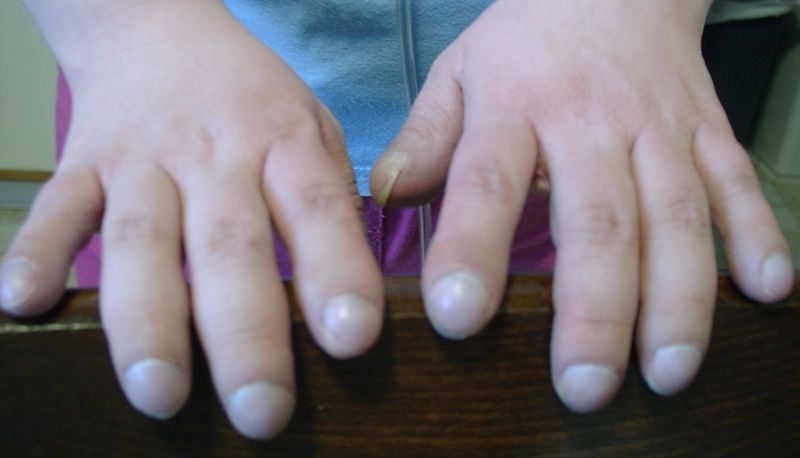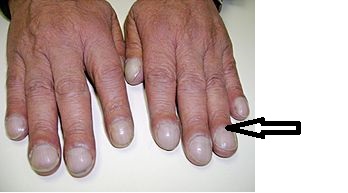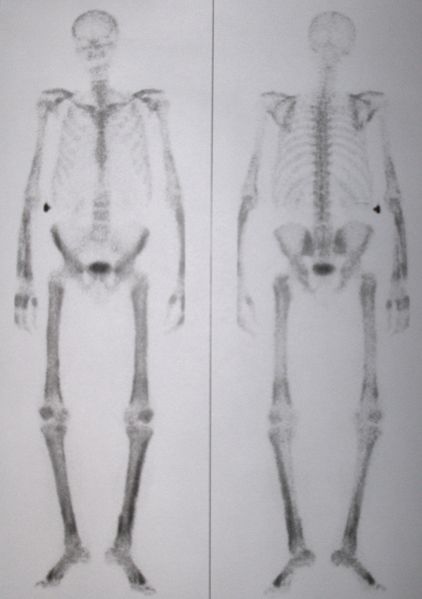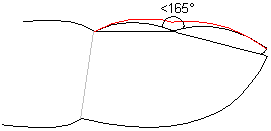Clubbing: Difference between revisions
No edit summary |
|||
| Line 14: | Line 14: | ||
==Overview== | ==Overview== | ||
In [[medicine]] | In [[medicine]] '''clubbing''' is a deformity of the [[finger]]s and [[Nail (anatomy)|fingernail]]s that is associated with a number of diseases, mostly of the [[heart disease|heart]] and [[lung disease|lungs]]. [[Idiopathic]] clubbing can also occur. | ||
==Historical Perspective== | ==Historical Perspective== | ||
Revision as of 19:19, 7 August 2012
| Clubbing | |
 | |
|---|---|
| Clubbing in the fingers of a 33-year old female with pulmonary hypertension. | |
| ICD-10 | R68.3 |
| ICD-9 | 781.5 |
|
WikiDoc Resources for Clubbing |
|
Articles |
|---|
|
Most recent articles on Clubbing |
|
Media |
|
Evidence Based Medicine |
|
Clinical Trials |
|
Ongoing Trials on Clubbing at Clinical Trials.gov Clinical Trials on Clubbing at Google
|
|
Guidelines / Policies / Govt |
|
US National Guidelines Clearinghouse on Clubbing
|
|
Books |
|
News |
|
Commentary |
|
Definitions |
|
Patient Resources / Community |
|
Directions to Hospitals Treating Clubbing Risk calculators and risk factors for Clubbing
|
|
Healthcare Provider Resources |
|
Causes & Risk Factors for Clubbing |
|
Continuing Medical Education (CME) |
|
International |
|
|
|
Business |
|
Experimental / Informatics |
Editor-In-Chief: C. Michael Gibson, M.S., M.D. [1]; Associate Editor-In-Chief: John Fani Srour, M.D.
Synonyms and keywords: Digital clubbing; Hippocratic fingers; drumstick fingers; watch glass nails; finger clubbing
Overview
In medicine clubbing is a deformity of the fingers and fingernails that is associated with a number of diseases, mostly of the heart and lungs. Idiopathic clubbing can also occur.
Historical Perspective
Hippocrates was probably the first to document clubbing as a sign of disease, and the phenomenon is therefore occasionally called Hippocratic fingers.
Pathophysiology
The exact cause for sporadic clubbing is unknown, and there are numerous theories as to its cause. Vasodilation (distended blood vessels), secretion of growth factors (such as platelet-derived growth factor and hepatocyte growth factor) from the lungs, and other mechanisms have been proposed. The discovery of disorders in the prostaglandin metabolism in primary osteo-arthropathy has led to suggestions that overproduction of PGE2 by other tissues may be the causative factor for clubbing.[1]
Associated Conditions
Although many diseases are associated with clubbing such as oxygen deprivation and lung, heart, or liver disease, the reports are fairly anecdotal. Prospective studies of patients presenting with clubbing have not yet been performed, and hence there is no conclusive evidence of these associations.
- Lung disease:
- Lung cancer, mainly large-cell (35% of all cases), not seen frequently in small cell lung cancer[2]
- Interstitial lung disease
- Tuberculosis
- Bronchiectasis
- Suppurative lung disease: lung abscess, empyema
- Cystic fibrosis
- Pulmonary hypertension
- Mesothelioma
- It is worth noting that clubbing is not associated with chronic obstructive pulmonary disease (COPD). Indeed, the presence of clubbing in a patient with COPD should prompt a search for an underlying (lung) cancer.
- Heart disease:
- Any disease featuring chronic hypoxia
- Congenital cyanotic heart disease (most common cardiac cause)
- Subacute bacterial endocarditis
- Atrial myxoma (benign tumor)
- Gastrointestinal and hepatobiliary:
- Malabsorption
- Crohn's disease and ulcerative colitis
- Cirrhosis, especially in primary biliary cirrhosis[3]
- Other liver diseases (in the "hepatopulmonary syndrome", a complication of cirrhosis)[4]
- Others:
- Hyperthyroidism (thyroid acropachy)[5]
- Familial and racial clubbing and "pseudoclubbing" (people of African descent often have what appears to be clubbing)
- Vascular anomalies of the affected arm such as an axillary artery aneurysm (in unilateral clubbing)
- HPOA
- A special form of clubbing is hypertrophic pulmonary osteo-arthropathy, known in continental Europe as Pierre Marie-Bamberger syndrome. (In dogs the condition is known as hypertrophic osteopathy.) This is the combination of clubbing and thickening of periosteum (connective tissue lining of the bones) and synovium (lining of joints), and is often initially diagnosed as arthritis. It is commonly associated with lung cancer.
- Primary HOA
- Primary hypertrophic osteo-arthropathy is HPOA without signs of pulmonary disease. This form has a hereditary component, although subtle cardiac abnormalties can occasionally be found. It is known in continental Europe as the Touraine-Solente-Golé syndrome. This condition has been linked to mutations in the gene on the fourth chromosome (4q33-q34)coding for the enzyme 15-hydroxyprostaglandin dehydrogenase (HPGD); this leads to decreased breakdown of prostaglandin E2 and elevated levels of this substance.[6]
- Secondary HOA
- It is usually associated with lung cancer, pulmonary infections, cystic fibrosis, right-to-left cardiac shunts, and less often in Hodgkin's lymphoma and cirrhosis. Among patients with lung cancer, HOA is most frequently associated with adenocarcinoma and least frequently with small cell carcinoma [7] Rarely, arterial vascular prosthesis infections may be associated with HOA[8]. Clinical features suggestive of vascular infection-related HOA include clubbing or periosteal new bone formation in a single limb.
Gross Pathology

Causes
Causes by Organ System
Causes in Alphabetical Order
- Achalasia
- Arteriovenous malformations
- Arterial vascular prosthesis infections [8]
- Atrial myxoma
- Bronchial carcinoma[10]
- Bronchiectasis
- Cannabis [11]
- Celiac Sprue[12]
- Cerebrovascular insult
- Chronic obstructive jaundice
- Cirrhosis
- Cyanotic congenital heart disease[13]
- Cystic Fibrosis[14]
- Endocarditis[15]
- Empyema
- Hepatoma
- Hodgkin's lymphoma[16]
- Interstitial lung disease
- Liver tumors
- Lung abscess[17]
- Metastatic melanoma[18]
- Mesothelioma[19]
- Myelofibrosis[20]
- Nasopharyngeal carcinoma[21]
- Pachydermoperiostosis
- POEMS syndrome (polyneuropathy, organomegaly, endocrinopathy, monoclonal gammopathy, and skin changes): a rare paraneoplastic syndrome secondary to a plasma cell dyscrasia in which clubbing may be seen. Other findings including peripheral neuropathy, organomegaly, endocrinopathy, monoclonal plasma proliferative disorder, skin changes, sclerotic bone lesions, Castleman disease, thrombocytosis, papilledema, peripheral edema, pleural effusions, ascites, and white nails.
- Primary biliary cirrhosis[22]
- Pulmonic stenosis
- Pulmonary artery sarcoma[23]
- Pulmonary fibrosis
- Pulmonary metastases
- Right-to-left cardiac shunts
- Sarcoidosis of the lungs [24]
- Silicosis[25]
- Thyroid cancer
- Thyrotoxicosis
- Tuberculosis
- Ulcerative colitis
- Vascular anomalies
Epidemiology and Demographics
The exact frequency of clubbing in the population is not known. A 2008 study found clubbing in 1% of all patients admitted to a department of internal medicine. Of these, 40% turned out to have significant underlying disease of various causes, while 60% had no medical problems on further investigations and remained well over the subsequent year.[26]
Diagnosis
Symptoms
Symptoms of the development of clubbing occur in five steps. They are as follows:[27]
- Fluctuation and softening of the nail bed (increased ballotability)
- Loss of the normal <165° angle ("Lovibond angle") between the nailbed and the fold (cuticula)
- Increased convexity of the nail fold
- Thickening of the whole distal (end part of the) finger (resembling a drumstick)
- Shiny aspect and striation of the nail and skin
Physical Examination
When clubbing is encountered in patients, doctors will seek to identify its cause. They usually accomplish this by obtaining a medical history— particular attention is paid to lung, heart, and gastrointestinal conditions —and conducting a clinical examination, which may disclose associated features relevant to a diagnosis.
Heart
Particular attention is paid to the heart in patients that present with digital clubbing.
Lungs
Particular attention is paid to the lungs in patients that present with digital clubbing.
Abdomen
Particular attention is paid to the abdomen because the doctor will be checking for gastrointestinal conditions that may be associated with digital clubbing.
Other Diagnostic Studies
Schamroth's test or Schamroth's window test (originally demonstrated by South African cardiologist Dr Leo Schamroth on himself[28]) is a popular test for clubbing. When the distal phalanges (bones nearest the fingertips) of corresponding fingers of opposite hands are directly apposed (placed against each other back to back), a small diamond-shaped "window" is normally apparent between the nailbeds. If this window is obliterated, the test is positive and clubbing is present.
-
Clubbing of the fingernail. The red line shows the outline of a clubbed nail.
The following image shows a bone scan of a person with a special form of clubbing called HPOA.

See also
- Periosteal reaction for more on HPOA and primary HOA
- Clubbed thumb
References
- ↑ Uppal S, Diggle CP, Carr IM, et al (June 2008). "Mutations in 15-hydroxyprostaglandin dehydrogenase cause primary hypertrophic osteoarthropathy". Nat. Genet. 40 (6): 789–93. doi:10.1038/ng.153. PMID 18500342
- ↑ Sridhar KS, Lobo CF, Altman RD. Digital clubbing and lung cancer. Chest 1998;114:1535-37. PMID 9872183
- ↑ Epstein O, Dick R, Sherlock S (1981). "Prospective study of periostitis and finger clubbing in primary biliary cirrhosis and other forms of chronic liver disease". Gut. 22 (3): 203–6. PMID 7227854.
- ↑ Naeije R. Hepatopulmonary syndrome and portopulmonary hypertension. Swiss Med Wkly. 2003;133:163-9. PMID 12715285.
- ↑ Template:GPnotebook
- ↑ Uppal S, Diggle CP, Carr IM; et al. (2008). "Mutations in 15-hydroxyprostaglandin dehydrogenase cause primary hypertrophic osteoarthropathy". Nat. Genet. 40 (6): 789–93. doi:10.1038/ng.153. PMID 18500342. Unknown parameter
|month=ignored (help) - ↑ Sridhar KS, Lobo CF, Altman RD (1998). "Digital clubbing and lung cancer". Chest. 114 (6): 1535–7. PMID 9872183. Unknown parameter
|month=ignored (help) - ↑ 8.0 8.1 Alonso-Bartolomé P, Martínez-Taboada VM, Pina T, Blanco R, Rodriguez-Valverde V (2006). "Hypertrophic osteoarthropathy secondary to vascular prosthesis infection: report of 3 cases and review of the literature". Medicine (Baltimore). 85 (3): 183–91. doi:10.1097/01.md.0000224714.27508.8b. PMID 16721260. Unknown parameter
|month=ignored (help) - ↑ http://picasaweb.google.com/mcmumbi/USMLEIIImages
- ↑ Sridhar KS, Lobo CF, Altman RD. Digital clubbing and lung cancer. Chest 1998;114:1535-37. PMID 9872183
- ↑ Schuller A, Cottin V, Hot A, Cordier JF (2008). "Finger clubbing and altered carbon monoxide transfer capacity in cannabis smokers". Eur. Respir. J. 31 (2): 473–4. doi:10.1183/09031936.00150907. PMID 18238953. Unknown parameter
|month=ignored (help) - ↑ Gajewska J, Ambroszkiewicz J, Hozyasz KK (2005). "[The impairement of bone formation and resorption in 25-year-old man with neglected celiac disease]". Wiad. Lek. (in Polish). 58 (5–6): 338–41. PMID 16238129.
- ↑ Pineda CJ, Guerra J, Weisman MH, Resnick D, Martinez-Lavin M (1985). "The skeletal manifestations of clubbing: a study in patients with cyanotic congenital heart disease and hypertrophic osteoarthropathy". Semin. Arthritis Rheum. 14 (4): 263–73. PMID 3909407. Unknown parameter
|month=ignored (help) - ↑ Van Ginderdeuren F, Van Cauwelaert K, Malfroot A (2006). "Influence of digital clubbing on oxygen saturation measurements by pulse-oximetry in cystic fibrosis patients". J. Cyst. Fibros. 5 (2): 125–8. doi:10.1016/j.jcf.2006.01.007. PMID 16504602. Unknown parameter
|month=ignored (help) - ↑ Ozdemir B, Sentürk T, Kaderli AA; et al. (2008). "Postoperative regression of clubbing at an unexpected rate in a patient with aortic and mitral valve replacement due to infective endocarditis". Ir J Med Sci. doi:10.1007/s11845-008-0231-2. PMID 18843516. Unknown parameter
|month=ignored (help) - ↑ Mullins GM, Lenhard RE (1971). "Digital clubbing in Hodgkin's disease". Johns Hopkins Med J. 128 (3): 153–7. PMID 5553121. Unknown parameter
|month=ignored (help) - ↑ Moreira Jda S, Camargo Jde J, Felicetti JC, Goldenfun PR, Moreira AL, Porto Nda S (2006). "Lung abscess: analysis of 252 consecutive cases diagnosed between 1968 and 2004". J Bras Pneumol. 32 (2): 136–43. PMID 17273583.
- ↑ Thompson MA, Warner NB, Hwu WJ (2005). "Hypertrophic osteoarthropathy associated with metastatic melanoma". Melanoma Res. 15 (6): 559–61. PMID 16314744. Unknown parameter
|month=ignored (help) - ↑ McGavin C, Hughes P (1998). "Finger clubbing in malignant mesothelioma and benign asbestos pleural disease". Respir Med. 92 (4): 691–2. PMID 9659538. Unknown parameter
|month=ignored (help) - ↑ Saghafi M, Azarian A, Nohesara N (2008). "Primary hypertrophic osteoarthropathy with myelofibrosis". Rheumatol. Int. 28 (6): 597–600. doi:10.1007/s00296-007-0477-4. PMID 18038138. Unknown parameter
|month=ignored (help) - ↑ Ali N, Abbasi AN, Karsan F, Hashmi R, Badar QA, Sheikh AJ (2009). "A case of finger clubbing associated with nasopharyngeal carcinoma in a young girl, and review of pathophysiology". J Pak Med Assoc. 59 (4): 253–4. PMID 19402293. Unknown parameter
|month=ignored (help) - ↑ Stoller JK, Moodie D, Schiavone WA; et al. (1990). "Reduction of intrapulmonary shunt and resolution of digital clubbing associated with primary biliary cirrhosis after liver transplantation". Hepatology. 11 (1): 54–8. PMID 2295472. Unknown parameter
|month=ignored (help) - ↑ Loredo JS, Fedullo PF, Piovella F, Moser KM (1996). "Digital clubbing associated with pulmonary artery sarcoma". Chest. 109 (6): 1651–3. PMID 8769527. Unknown parameter
|month=ignored (help) - ↑ West SG, Gilbreath RE, Lawless OJ (1981). "Painful clubbing and sarcoidosis". JAMA. 246 (12): 1338–9. Unknown parameter
|month=ignored (help) - ↑ Ehrlich RI, Gerston KF, Lalloo UG (1988). "Accelerated silicosis in a foundry shotblaster. A case report". S. Afr. Med. J. 73 (2): 128–30. PMID 3340919. Unknown parameter
|month=ignored (help) - ↑ Vandemergel X, Renneboog B (2008). "Prevalence, aetiologies and significance of clubbing in a department of general internal medicine". Eur. J. Intern. Med. 19 (5): 325–9. doi:10.1016/j.ejim.2007.05.015. PMID 18549933. Unknown parameter
|month=ignored (help) - ↑ Myers KA, Farquhar DR (2001). "The rational clinical examination: does this patient have clubbing?". JAMA. 286: 341–7. doi:10.1001/jama.286.3.341. PMID 11466101.
- ↑ Schamroth L (1976). "Personal experience". S. Afr. Med. J. 50 (9): 297–300. PMID 1265563. Unknown parameter
|month=ignored (help)
